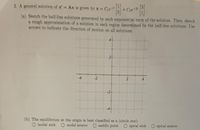
Calculus: Early Transcendentals
8th Edition
ISBN: 9781285741550
Author: James Stewart
Publisher: Cengage Learning
expand_more
expand_more
format_list_bulleted
Concept explainers
Question

Transcribed Image Text:### Differential Equations and Stability Analysis
#### Problem Statement:
2. A general solution of \( \mathbf{x}' = \mathbf{A}\mathbf{x} \) is given by \( \mathbf{x} = C_1 e^{-t} \begin{bmatrix} 1 \\ 2 \end{bmatrix} + C_2 e^{-2t} \begin{bmatrix} 3 \\ 1 \end{bmatrix} \).
(a) Sketch the half-line solutions generated by each exponential term of the solution. Then, sketch a rough approximation of a solution in each region determined by the half-line solutions. Use arrows to indicate the direction of motion on all solutions.
*Graph:*
The graph provided is a coordinate plane with x-axis and y-axis ranging from -4 to 4. The goal is to sketch solution trajectories for the given differential equation, indicating the direction of motion with arrows.
(b) The equilibrium at the origin is best classified as a (circle one):
- Nodal sink
- Nodal source
- Saddle point
- Spiral sink
- Spiral source
(*Circle one choice*).
Explanation of the Graph:
- The graph is a standard Cartesian coordinate system with both axes extending from -4 to 4.
- The directions of the half-lines can be derived from the general solution, specifically the terms involving \( e^{-t} \) and \( e^{-2t} \).
Guidance:
In the analysis:
1. Determine the eigenvalues and eigenvectors of matrix \( \mathbf{A} \).
2. Use the eigenvectors to draw straight-line solutions extending from the origin.
3. Arrows should indicate whether the solutions are moving towards or away from the origin over time, based on the exponential terms in the solution:
- \( e^{-t} \) indicates movement towards the origin.
- \( e^{-2t} \) indicates movement towards the origin (at a faster rate than \( e^{-t} \)).
For part (b), analyze the nature of the equilibrium (at the origin):
- **Nodal Sink**: Solutions are straight lines approaching the origin.
- **Nodal Source**: Solutions are straight lines diverging from the origin.
- **Saddle Point**: Solutions diverge from the origin in some directions and converge in others.
- **Spiral Sink/Source**: Solutions spiral towards/away from the origin.
Using the provided solution form,
Expert Solution
This question has been solved!
Explore an expertly crafted, step-by-step solution for a thorough understanding of key concepts.
This is a popular solution
Trending nowThis is a popular solution!
Step by stepSolved in 2 steps with 2 images

Knowledge Booster
Learn more about
Need a deep-dive on the concept behind this application? Look no further. Learn more about this topic, calculus and related others by exploring similar questions and additional content below.Similar questions
Recommended textbooks for you
 Calculus: Early TranscendentalsCalculusISBN:9781285741550Author:James StewartPublisher:Cengage Learning
Calculus: Early TranscendentalsCalculusISBN:9781285741550Author:James StewartPublisher:Cengage Learning Thomas' Calculus (14th Edition)CalculusISBN:9780134438986Author:Joel R. Hass, Christopher E. Heil, Maurice D. WeirPublisher:PEARSON
Thomas' Calculus (14th Edition)CalculusISBN:9780134438986Author:Joel R. Hass, Christopher E. Heil, Maurice D. WeirPublisher:PEARSON Calculus: Early Transcendentals (3rd Edition)CalculusISBN:9780134763644Author:William L. Briggs, Lyle Cochran, Bernard Gillett, Eric SchulzPublisher:PEARSON
Calculus: Early Transcendentals (3rd Edition)CalculusISBN:9780134763644Author:William L. Briggs, Lyle Cochran, Bernard Gillett, Eric SchulzPublisher:PEARSON Calculus: Early TranscendentalsCalculusISBN:9781319050740Author:Jon Rogawski, Colin Adams, Robert FranzosaPublisher:W. H. Freeman
Calculus: Early TranscendentalsCalculusISBN:9781319050740Author:Jon Rogawski, Colin Adams, Robert FranzosaPublisher:W. H. Freeman
 Calculus: Early Transcendental FunctionsCalculusISBN:9781337552516Author:Ron Larson, Bruce H. EdwardsPublisher:Cengage Learning
Calculus: Early Transcendental FunctionsCalculusISBN:9781337552516Author:Ron Larson, Bruce H. EdwardsPublisher:Cengage Learning

Calculus: Early Transcendentals
Calculus
ISBN:9781285741550
Author:James Stewart
Publisher:Cengage Learning

Thomas' Calculus (14th Edition)
Calculus
ISBN:9780134438986
Author:Joel R. Hass, Christopher E. Heil, Maurice D. Weir
Publisher:PEARSON

Calculus: Early Transcendentals (3rd Edition)
Calculus
ISBN:9780134763644
Author:William L. Briggs, Lyle Cochran, Bernard Gillett, Eric Schulz
Publisher:PEARSON

Calculus: Early Transcendentals
Calculus
ISBN:9781319050740
Author:Jon Rogawski, Colin Adams, Robert Franzosa
Publisher:W. H. Freeman


Calculus: Early Transcendental Functions
Calculus
ISBN:9781337552516
Author:Ron Larson, Bruce H. Edwards
Publisher:Cengage Learning